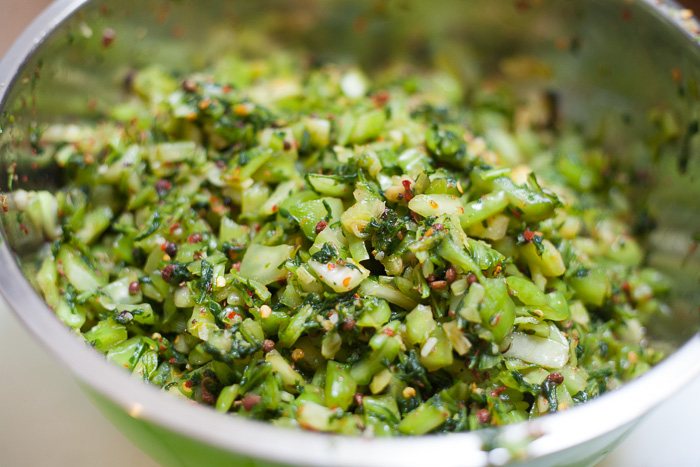Kunming-Style Pickles
November 23rd, 2013

Fall is pickling season in Kunming. Chefs, home cooks, and the ladies that run all of the many noodle stands around the city buy huge armloads of thick mustard greens, known locally as kǔcài (苦菜) or “bitter vegetable” (often found under the name “da jie cai”—大芥菜 in markets in the US) and lay them out in the sun to dry out until they’re thoroughly wilted. When the greens are ready, they chop them up and mix them with crushed dried chile, Sichuan peppercorns, and copious amounts of salt, kneading the mixture in huge plastic tubs until everything is well mixed and the vegetables have started giving up their remaining juices. The pickles are then sealed up and left to ferment like sauerkraut. The pickles are ready to use in just about a week, but many cooks keep them much longer, for up to a year, letting the flavors deepen with time.
To make these pickles at home, we just use fresh mustard greens without drying them. We also add a bit of rice (a trick we learned from a cook in a noodle stall down the street from our apartment on Luofeng Jie) to help start the fermentation. Traditionally, these pickles are made in special pickle jars that use a well along the lip of the jar to form a water seal, and these jars can be ordered from the Wok Shop, but you can also use the method cooks use to make sauerkraut by using a regular jar or plastic container and adding a weighted plate or cup to hold down the vegetables and make sure they stay submerged in the liquid.

Ingredients for Kunming-style pickles: mustard greens, chili flakes, sichuan peppercorns, salt
4 lbs. mature mustard greens
4 tbsp salt, plus extra for the jar
3 tbsp dried chili flakes
3 tbsp Sichuan peppercorns
1 tbsp cooked rice
Cut the mustard greens cross-wise into 1/4″ strips. (You should have about 18 cups.) Put the greens into a large bowl with all the other ingredients and massage/knead the mixture forcefully for 3-4 minutes, until the volume has reduced by half and the vegetables have given up much of their moisture and become limp. Sterilize a pickle jar with a bleach solution or boiling water, and put the pickle mixture into the jar with all of its juices, pressing down with a sterile spoon so that all of the vegetables are covered with liquid. (If the vegetables are not covered with liquid, you can add a bit of water.) Sprinkle a little bit of salt on top of the mixture. If working with a traditional pickle jar, pour water into the well around the lip of the jar and cover with the lid. Alternatively, top the vegetables with a plate just smaller than the container’s opening (or, if using a narrow jar, with a cup whose base is just smaller than the opening) and place cans or rocks on the plate to keep everything weighed down. Leave the pickles to ferment for about a week, then taste them with a sterile spoon. If they have a nice pickle-like flavor, transfer them to airtight jars or containers and store them in the refrigerator.

Prepared greens ready for the pickling jar
Photos: Georgia Freedman, Josh Wand (2)



